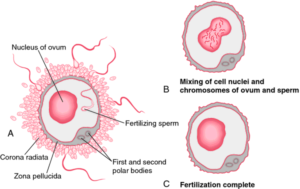Question
Which process is occurring at X?
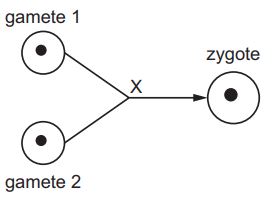
fertilisation
mitosis
pollination
meiosis
▶️Answer/Explanation
A
The process is occurring at X is fertilization. When gamete 1 and gamete 2 (sperm and egg cells, respectively) meet and fuse, they form a zygote through a process known as fertilization. Fertilization is the fusion of these two specialized reproductive cells, each contributing half of the genetic material needed to create a new individual. This genetic combination results in the formation of a diploid zygote, which has a full set of chromosomes (one set from each parent) and marks the beginning of a new organism’s development. The zygote then undergoes multiple rounds of cell division and differentiation to eventually develop into a mature organism.
Question
What are involved in reproduction in both animals and plants?
A ovary and embryo
B ovary and testes
C ovule and stigma
D uterus and embryo
▶️Answer/Explanation
The correct answer is:
A. ovary and embryo
In animals, reproduction typically involves the interaction of male and female reproductive structures. The male usually produces sperm cells in the testes, and the female typically has ovaries that produce eggs (ova). Fertilization occurs when a sperm cell from the male fertilizes an egg cell from the female, resulting in the formation of an embryo.
In plants, reproduction also involves male and female reproductive structures. The ovary contains ovules, which are female reproductive cells. The stigma is a part of the female reproductive structure (the pistil) that receives pollen from the male reproductive structures (anthers). Fertilization in plants occurs when pollen from the male parts fertilizes the ovules in the ovary, leading to the development of seeds and eventually embryos within the seeds.
So, option A (ovary and embryo) is the correct answer for both animals and plants.
Question
Which species can breed with Prunella vulgaris to produce fertile offspring?
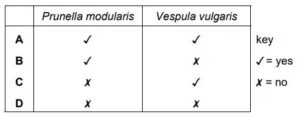
▶️Answer/Explanation
Ans: D
Prunella vulgaris, commonly known as self-heal or heal-all, is a herbaceous flowering plant in the in the mint family (Lamiaceae family). While it primarily reproduces through seeds, it is not known to hybridize naturally with other species to produce fertile offspring. Therefore, neither Prunella modularis (commonly known as the dunnock) nor Vespula vulgaris (common wasp) can breed with Prunella vulgaris to produce fertile offspring, as they are from entirely different biological kingdoms (animals and plants). Hybrids between different plant species are relatively rare and often result in sterile or partially sterile offspring due to genetic incompatibilities.
Question
The table lists some processes which take place during reproduction in flowering plants and
mammals.
Which row is correct?

▶️Answer/Explanation
Ans: A
Fertilization Needed:
- Flowering Plants: Fertilization is needed in flowering plants. It involves the fusion of the male gamete (pollen) and the female gamete (egg) to form a zygote, which develops into an embryo within the seed.
- Mammals: Fertilization is also needed in mammals. It involves the fusion of the sperm cell and the egg cell to form a zygote, which develops into an embryo within the mother’s womb.
Implantation Needed: Implantation is needed in mammals. After fertilization, the developing embryo needs to attach to the lining of the mother’s uterus (womb) for further development and proper nutrient exchange.
Pollination Needed: Pollination is needed in flowering plants. Pollination is the transfer of pollen from the male reproductive structure (anther) to the female reproductive structure (stigma) of a flower. This process is crucial for fertilization to occur.
Question
The diagram shows Hydra growing and releasing an offspring from the side of its body.

Which row is correct?
| parent and offspring are genetically identical | uses sexual reproduction | |
A B C D | ✓ ✓ ✗ ✗ | ✓ ✗ ✓ ✗ |
▶️Answer/Explanation
B
Hydra is a fascinating organism known for its ability to regenerate and reproduce asexually through a process called budding. In budding, a new individual, known as the “bud” or “offspring,” grows as an outgrowth or protrusion from the parent’s body. The offspring and parent are genetically identical because the offspring is essentially a clone of the parent. This type of asexual reproduction allows Hydra to reproduce rapidly and efficiently under favorable conditions.
- The parent Hydra develops a small outgrowth or bud on its side.
- The bud continues to grow and develop while still attached to the parent.
- Eventually, the bud becomes a complete and independent organism.
- The bud detaches from the parent Hydra, becoming a separate entity.
This process results in two genetically identical organisms – the parent Hydra and the offspring Hydra – since there is no genetic recombination or mixing of genetic material involved in asexual reproduction like budding.
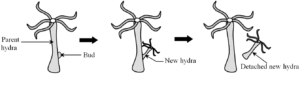
Question
Which statement about sexual reproduction is correct?
A It is a process that involves the fusion of two nuclei.
B It always produces genetically identical offspring.
C No zygote is formed.
D There is no fertilization.
▶️Answer/Explanation
The correct statement about sexual reproduction is:
A. It is a process that involves the fusion of two nuclei.
Sexual reproduction involves the fusion of gametes (sperm and egg cells), each containing a single nucleus with half the genetic material of the parent, to form a zygote with a full set of genetic material. This fusion of nuclei is known as fertilization, and it leads to genetic diversity in offspring due to the combination of genetic material from two different parents.
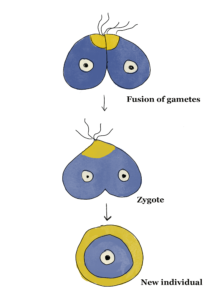
Question
What is formed when the nucleus of a sperm fuses with the nucleus of an egg?
A gamete
B ovule
C stamen
D zygote
▶️Answer/Explanation
The correct answer is D) zygote.
When the nucleus of a sperm cell fuses with the nucleus of an egg cell, it forms a zygote. A zygote is the initial cell that results from the fertilization of an egg by a sperm. This fusion of genetic material from both parents marks the beginning of a new individual’s development. The zygote contains a complete set of chromosomes – half from the mother and half from the father – and it has the potential to undergo multiple rounds of cell division, ultimately developing into a more complex multicellular organism. The zygote is the starting point of embryonic development.
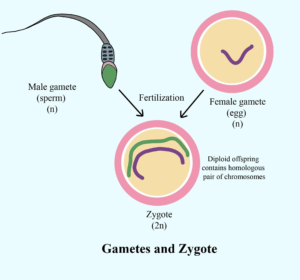
Question
The diagram shows what happens during fertilization.
egg + sperm → fertilized egg → male embryo
Which sex chromosomes are present in the egg, sperm and fertilized egg shown?
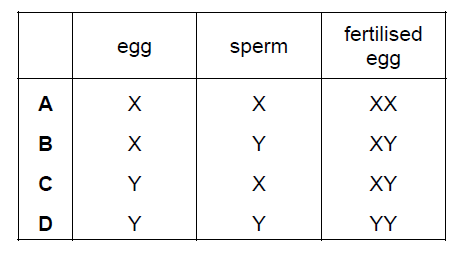
▶️Answer/Explanation
B
The sex chromosomes are designated as X and Y and sex determination is based on the combination of sex chromosomes in the egg and sperm that come together during fertilization.
An egg (ova) carries one X chromosome, while a sperm can carry either an X chromosome or a Y chromosome. The fertilized egg (zygote) will have one set of sex chromosomes from the egg and one from the sperm.
For the scenario where a male embryo is formed:
– Egg (ova): X chromosome
– Sperm: Y chromosome
– Fertilized egg (zygote; male embryo): X (from egg) + Y (from sperm) = XY
The combination of an X chromosome from the egg and a Y chromosome from the sperm results in an XY chromosome pattern, which typically leads to the development of a male embryo.
Question
Which statement about reproduction is correct?
A All living species can reproduce asexually.
B Gametes are needed for asexual reproduction.
C Only organisms that are separated from other organisms of the same species can reproduce
asexually.
D Some organisms reproduce asexually and sexually.
▶️Answer/Explanation
The correct statement is:
D. Some organisms reproduce asexually and sexually.
Asexual reproduction involves the production of offspring without the involvement of gametes (sex cells) and typically results in genetically identical offspring, as there is no genetic recombination. Some organisms can reproduce asexually through processes like budding, fragmentation, or binary fission.
Sexual reproduction, on the other hand, involves the fusion of gametes (sperm and egg cells) from two parents, leading to genetic diversity in the offspring due to genetic recombination during the formation of gametes.
There are many living species that are capable of both asexual and sexual reproduction, allowing them to utilize different reproductive strategies based on the environmental conditions and other factors.
Question
Fertilisation is the fusion of which parts of two cells?
A cell walls
B cytoplasm
C nuclei
D vacuoles
▶️Answer/Explanation
C
Fertilization is the process by which two gametes, or sex cells, typically a sperm cell and an egg cell, fuse to form a zygote. The fusion of these two gametes involves the combination of their genetic material, specifically their nuclei. Each gamete contains half of the genetic material needed to create a new individual, and fertilization brings these two halves together to restore the full complement of genetic material necessary for the development of a new organism.
During fertilization, the nuclei of the sperm and egg cells come together in a process called nuclear fusion. The sperm cell, which carries genetic material in its nucleus, enters the egg cell and releases its nucleus. The two nuclei then combine, creating a zygote with a complete set of genetic instructions from both parents. This zygote will undergo cell division and development to eventually form a new individual with a unique combination of genetic traits inherited from both parents.
